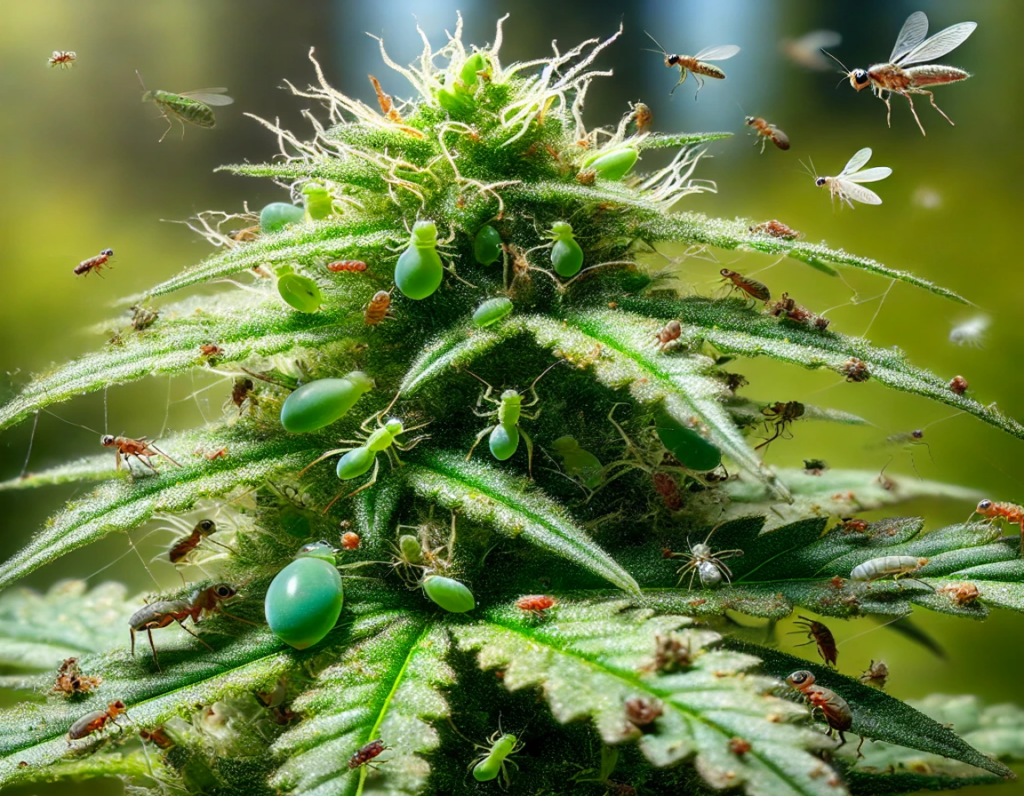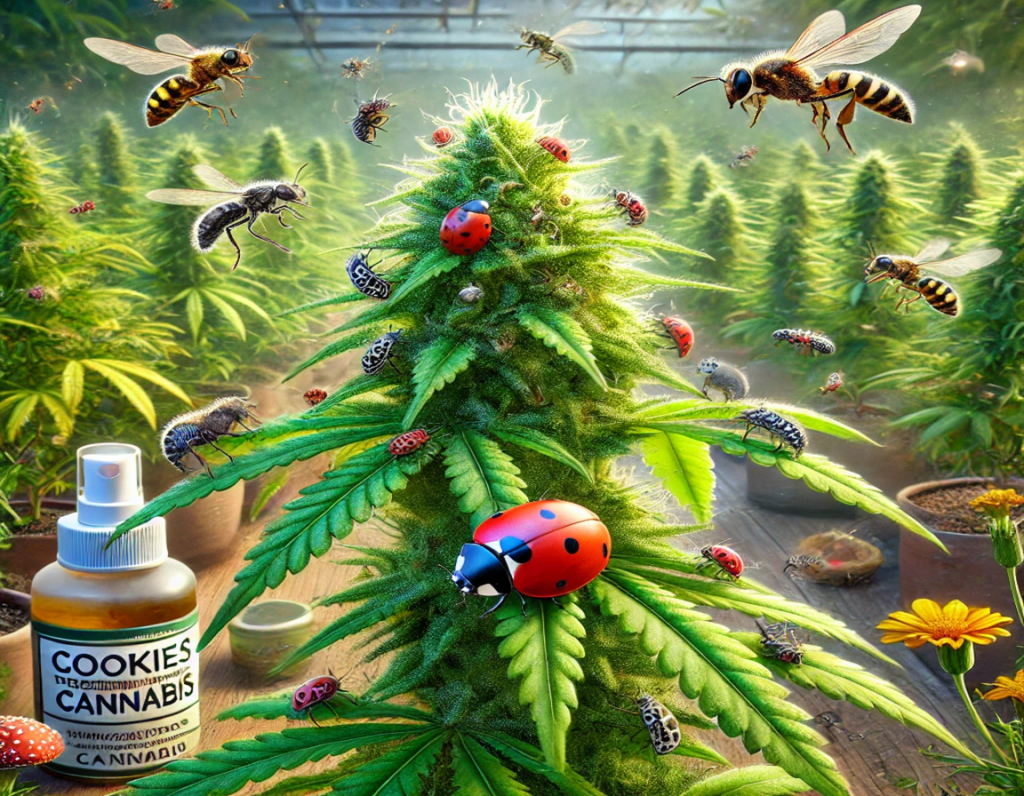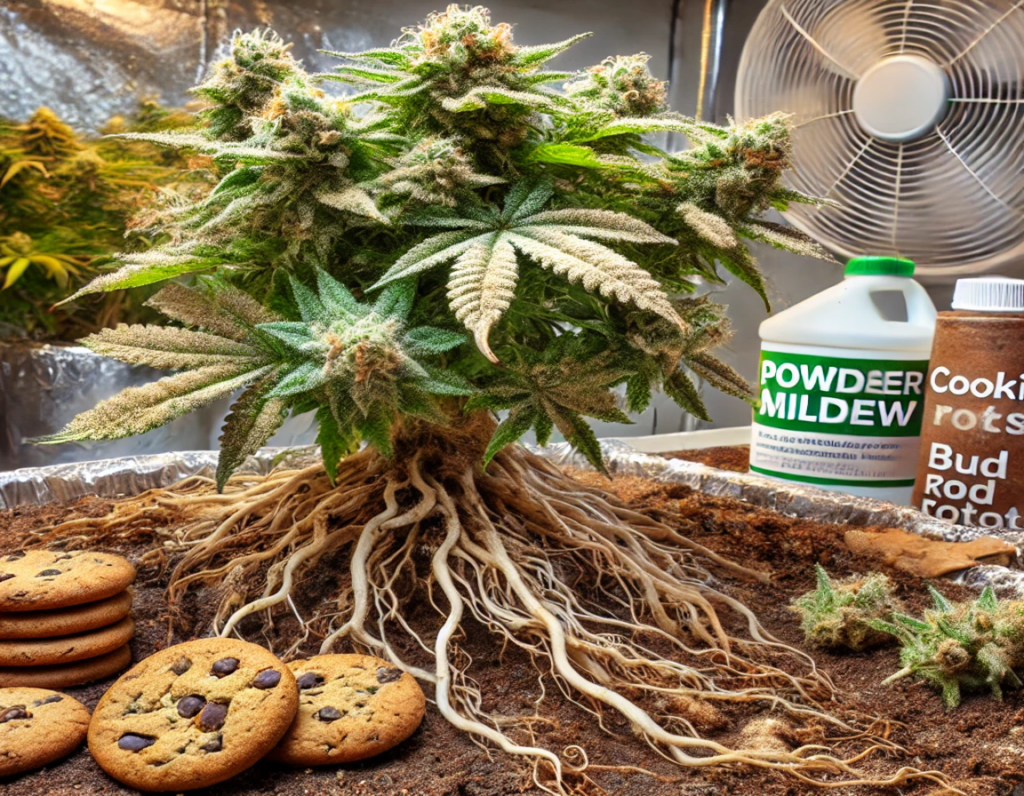
Canadian cannabis growers, particularly those cultivating Cookies strains, face challenges from a variety of pests that can harm their plants. The most common pests you may encounter in your Cookies Seeds garden include aphids, spider mites, and whiteflies. These pests damage your plants by feeding on their sap, weakening them and reducing your yield.
Aphids are tiny, soft-bodied insects that typically gather in clusters on the undersides of leaves. They feed by sucking the sap from the plant, causing yellowing, stunted growth, and wilting leaves. Spider mites, another common pest, are even smaller but just as destructive, leaving yellow or white speckling on leaves, which can lead to leaf drop if the infestation is severe. Whiteflies, tiny white insects, are also notorious for spreading plant diseases and weakening plants by feeding on their sap. They flutter up in clouds when disturbed, making them easy to spot.
Regular inspections of your garden are key to early detection and preventing infestations from spreading. Check the undersides of leaves, stems, and around the base of your plants for signs of pests like webbing, spots, or yellowing.

Once you’ve identified a pest issue, the next step is to control it without using harmful chemicals that can affect your garden’s health. Canadian growers can rely on natural predators and organic sprays to control pest populations.
Such as ladybugs, predatory mites, and parasitic wasps are excellent at keeping pest populations in check. Ladybugs are natural predators of aphids, while predatory mites target spider mites, and parasitic wasps help reduce whitefly populations. You can purchase these beneficial insects and introduce them into your garden as a natural pest control measure.
Another organic solution is the use of natural sprays like neem oil, insecticidal soap, or garlic spray. Neem oil is an effective treatment for a variety of pests because it disrupts their life cycle, preventing them from feeding, reproducing, and growing. Insecticidal soap kills soft-bodied insects like aphids and whiteflies on contact by breaking down their protective coating. Garlic spray, a homemade remedy, repels pests with its strong odor while being safe for plants.
Is another method you can use to repel pests. Certain plants, such as marigolds, basil, and dill, naturally deter pests due to their scent. Planting these herbs alongside your Cookies strains will create an extra layer of protection for your plants. Companion planting also promotes a healthy ecosystem, attracting beneficial insects that prey on pests.

In addition to pests, your Cookies Seeds garden may also face threats from common plant diseases. Canadian cannabis growers should be on the lookout for powdery mildew, bud rot, and root rot, all of which can spread rapidly if not controlled.
Appears as a white, powdery substance on leaves and buds, and it thrives in environments with high humidity and poor airflow. This disease weakens plants by preventing them from photosynthesizing effectively. Bud rot, a fungal disease that starts inside cannabis buds, is often only noticed once the buds are visibly affected, leading to their eventual decay. Root rot, another fungal disease, attacks the roots of plants, causing them to become mushy and brown, cutting off the plant’s ability to absorb water and nutrients.
To prevent these diseases, maintain good airflow around your plants, reduce humidity, and avoid overwatering. For outdoor growers, ensure adequate space between plants to promote ventilation. Indoor growers should use fans and dehumidifiers to keep the air circulating and humidity levels low.
Treating these diseases with organic products is possible. For powdery mildew, sulfur-based sprays or a homemade mixture of water and baking soda can be effective. For root rot, use a solution of hydrogen peroxide and water to kill the fungus and oxygenate the roots.

The best defense against pests and diseases is a strong, healthy growing environment. By creating optimal conditions, you can reduce the likelihood of infestations and infections in your Cookies Seeds garden.
Temperature and humidity control
Canadian growers need to monitor their environment carefully, as the country’s climate can vary greatly. Outdoor growers must keep an eye on weather conditions and take action to protect their plants from extreme weather. Indoor growers have more control over the environment and should use tools like dehumidifiers, air conditioners, and fans to maintain ideal temperature and humidity levels.
Equally important overwatering is a common mistake that can lead to root rot and attract pests like fungus gnats. Ensure that your soil has good drainage, and allow the top layer to dry out before watering again. Using high-quality organic soil enriched with compost or worm castings can strengthen your plants’ natural defenses, making them more resistant to both pests and diseases.
Providing your plants with the right balance of nutrients through natural fertilizers like fish emulsion, kelp meal, or bone meal can also help them grow strong and healthy. Healthy plants are much less likely to succumb to pests or diseases than weak, malnourished ones.

In addition to natural methods and optimal growing conditions, physical barriers are another layer of protection that Canadian growers can use to safeguard their Cookies Seeds garden from pests.
For outdoor growers, pests like rabbits, deer, and even rodents can pose a threat to your plants. Installing garden netting or fencing is a great way to keep larger animals out of your garden. Netting and fencing can also help protect your plants from strong winds or heavy rain, which can damage delicate buds.
To protect against smaller pests like slugs and snails, you can use copper tape or copper rings around the base of your plants. Copper repels these pests naturally and can prevent them from climbing up and feeding on your plants.
Sticky traps are another effective method for catching flying pests like whiteflies and aphids. These traps are inexpensive and easy to place around your garden to help monitor pest populations and prevent damage before it occurs.
Another important step in preventing the spread of pests or disease is pruning. By regularly pruning your plants and removing any damaged or diseased leaves, you can prevent infections from spreading. This simple yet effective step keeps your plants healthy and strong throughout the growing season.
Introducing ladybugs is an effective natural way to control aphids, as they are natural predators. You can also use neem oil or insecticidal soap to reduce aphid populations without harming your plants.
Powdery mildew appears as a white, powdery coating on leaves and buds. To treat it, ensure good airflow and low humidity. You can also use sulfur sprays or a mixture of water and baking soda to manage the mildew.
Root rot is often caused by overwatering or poor drainage. To prevent it, ensure your soil drains well and avoid water pooling around the base of your plants. If you notice root rot, a mix of hydrogen peroxide and water can help treat it.
Common pests include aphids, spider mites, and whiteflies. Outdoor growers should also watch for larger pests like rabbits and deer. Regular inspections will help you catch these pests before they cause significant damage.
We ship and deliver world wide via USPS and various couriers.
We offer a wide range of secure and anonymous online payment options.
We care about you, our customer. Please contact us with any questions or concerns.
Find out more about the benefits of being a loyal and regular customer.
WE ARE EVERY GROWERS ONE STOP SHOP TO ACQUIRE PREMIUM CANNABIS SEEDS FOR SALE IN THE USA, CANADA AND AUSTRALIA

Farmers Lab Seeds 2024, | All Right Reserved
Seeds are sold as novelty items, souvenirs, and collectibles. They contain 0% THC. We encourage our customers to check the legislation in their Country, State, Province, and Municipality prior to purchasing items from our store. We do not provide growing information.
All seeds are sold as hemp, and lab tested under 0.3% THC. This product is not for use by or sale to persons under the age of 21. This product should be used only as directed on the label. It should not be used if you are pregnant or nursing. Consult with a physician before use if you have a serious medical condition or use prescription medications. A Doctor’s advice should be sought before using this and any supplemental dietary product. All trademarks and copyrights are property of their respective owners and are not affiliated with nor do they endorse this product.
These statements have not been evaluated by the FDA. This product is not intended to diagnose, treat, cure or prevent any disease. Individual weight loss results will vary. By using this site, you agree to follow the Privacy Policy and all Terms & Conditions printed on this site. Void Where Prohibited by Law.